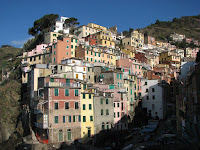
No sooner had we settled in then we were off to visit the local hospital. John has been unable to shake off a congested nose and his hearing in his left ear has completely gone. The hostel owner , Maxi, took us to the hospital and John was seen by an ear, nose and throat specialist. The specialist had an old-fashioned head light to look inside John's ears and then he pulled out some dried up wax. I have only ever seen those headlights in childrens' picture books. We had to wait quite a long time and the professionals only spoke a little English but we managed to be understood. John's family has a history of ear problems so he will have to have further tests when we arrive home and for now he has to walk on my right so he can hear me nagging!
We booked a week long stay in Rome as we had new credit cards sent to the New Zealand Embassy for us. One of the hassles of travelling longer than 2 years is that the cards expire while you are away and the banks need somewhere secure to send the new ones. While we were waiting for the new cards we had to stockpile some cash in case our old cards were cancelled and then we would not have been able to get any cash out of the ATMs. While we are carrying some travellers' cheques, we aren't carrying enough to cover several weeks' travel expenses. When we picked up the new cards we noticed that one type expired 6 days later. The replacement of them was treated as though they were lost cards and so, had a short validity. Fortunately the second type of card can be used for all the transactions we need.
We spent a lot of time looking around the city and walked to the Pincio Hill for a good view of the city. It was noticeable how few visitors were in the city.
We really enjoyed visiting the Pantheon which is so well-preserved having been built in 27BC. The ceiling is open to the weather and 22 drain holes in the marble floor allow the water to drain away.
There were several groups of students trying to warm up in the sun on the Spanish Steps. The restaurants around the Piazzas had their gas heaters blazing to encourage customers to sit outside and eat but they were not very successful as it was obviously snowing outside the city and the overnight temperatures fell to -4 Celcius.

One day was spent looking at the Vatican Museums. Of course the most popular place to visit was the Sistine chapel. We took our time, but all the tourist groups are timetabled to go through. They whizz past to look at just a few of the treasures in the time they have allocated to them. They charge through the middle of the corridors and there was space on the sides to look at the tapestries, sculptures, maps, and frescoes. We were even able to sit down in the Sistine and savor Michaelangelo's fabulous art work. The Egyptian Collection was popular too and there were not so many people there. There were a handful of people in the lower floors of the Etruscan Museum and we were the only ones on the higher floors. It was interesting to see the ceramic houses they made to store their cremated remains.

On another day we visited St Peter's Basilica and Square. The queue stretched half way around the square but moved very quickly. As we got to the front of the line I saw x-ray machines and signs saying no knives or scissors. I had a wine bottle opener with a small blade, and a vegetable knife to cut fruit for lunch with. Fortunately, the person on the x-ray never saw them and may have been on his cellphone at the time!
We visited several of the piazzas at different times and in several there were children in fancy dress being entertained by singers, magicians and entertainers. The most popular boys' costume was Zoro. This is all part of the carnival or pre-Easter festivities. This street performer has been following us all over Western Europe!

Travelling around the city was so easy. We bought a 6 day ticket and it gave us unlimited use of the trams, buses, and metro and all had their routes posted at the stops.
We spent another whole day at the Roman Forum and Palatine Hills, and the Colosseum across the street. There is a combined ticket for both areas but the Roman Forum ticket area was a shambles with only 3 cashiers, explaining the ticket system, and audio hire to each customer in about 4 different languages. Under our occupational health and safety rules they would be able to get compensation for work stress! It was incredible to see how badly organised it was when this site has been operating for ever, they could get lessons from the Vatican organisers.

We spent our final day visiting the catacombs outside the city at Appia Antica (Appian Way). We walked a few kilometres along the old Roman Road that was once lined with 6000 crucified slaves, after the revolt led by Spartacus.

We really enjoyed our time in Rome.






































